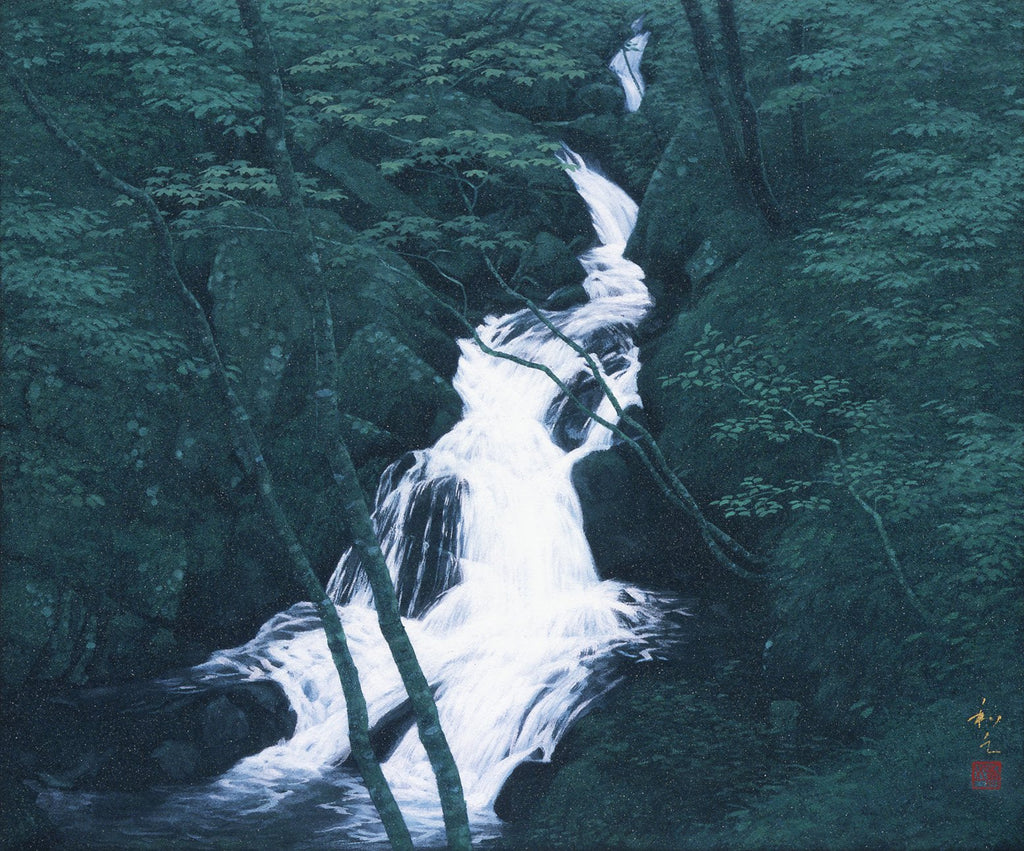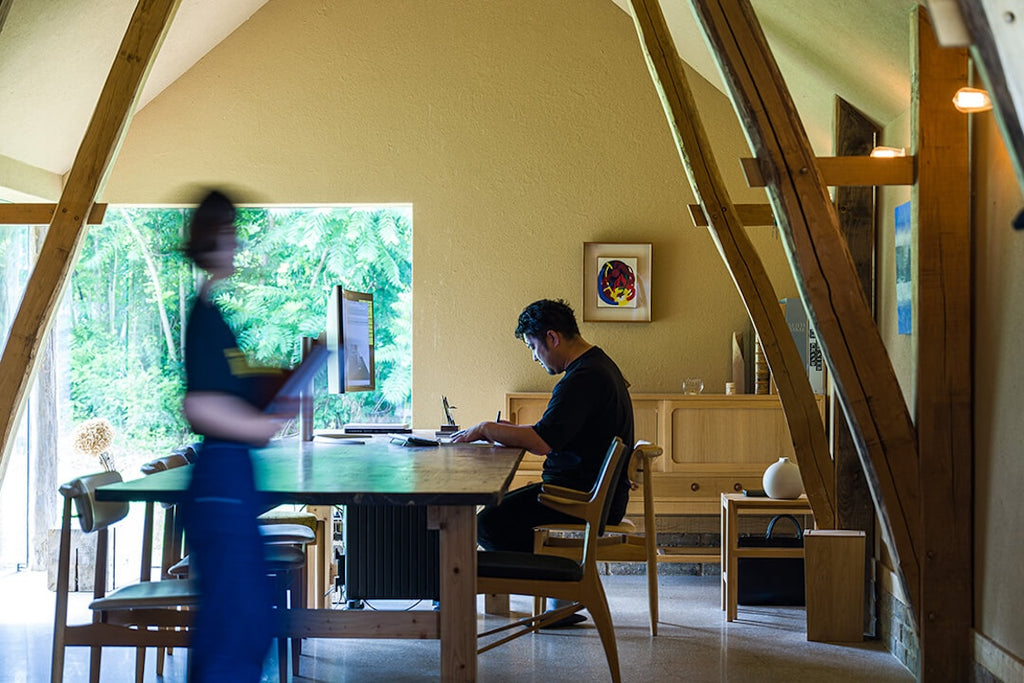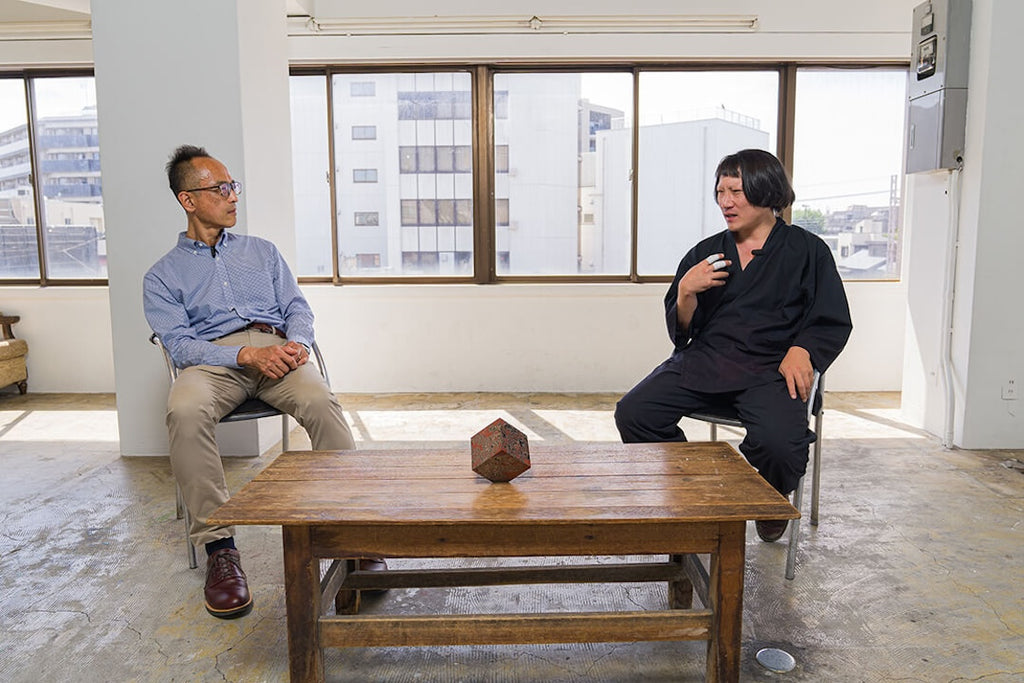ARTICLES
Kazuyuki Futagawa × Meiji Hijikata | Weaving Illusion and Reality into the Coexistence of Nature and Humanity
2023.12.14
INTERVIEW

Meiji Hijikata × Kazuyuki Futagawa
This series of articles features conversations between various artists and Meiji Hijikata, Director of the Taro Okamoto Museum of Art, Kawasaki, to look deeper into their artworks. The third installment is a dialogue with Kazuyuki Futagawa, an artist who has been waving his paintbrush in Nihonga (Japanese painting) for many years.
The first part of their dialogue explored Futagawa's artistic curiosity during his art university years and the growth and conflicts he experienced as a Nihonga artist. The second part delves into the origins of Futagawa's artworks. From familiar landscapes to Oirase and Yakushima, his art has taken a complete look at nature. Now he is exploring new artistic expressions under "the coexistence of humans and nature. " The conversation unravels an artistic progression that combines tradition with a playful spirit.
The Oirase Challenge: Confronting the Beauty of Nature

Kazuyuki Futagawa "River 8-A", mineral pigments on Japanese paper
Hijikata: You mentioned that you focused on landscape paintings when you became a professional artist. What kind of landscapes did you paint?
Futagawa: I painted familiar landscapes around me. I was living in Kawagoe at the time, so I usually painted the scenes around Kawagoe. But there was one time when I decided to paint the scenery of Oirase on a whim. The rich nature of Oirase truly brought out the beauty of mineral pigments to the fullest. Since then, Oirase has become one of the main subjects of my paintings.
Hijikata: How many years ago was that?
Futagawa: I was around 35 years old at the time, so it was over 30 years ago. I pondered a lot about how I should paint the scenery of Oirase. For example, when painting a flowing river, the easiest way is to paint it flowing from right to left. On the other hand, painting it flowing towards the foreground is the most difficult, but from this perspective, I can best embody the nature of Oirase, so I took the effort to paint it this way.

Kazuyuki Futagawa "Unsuikyo", 2020, 80.3 × 116.7 cm, mineral pigment on Japanese paper
Pursuing Realism and the Abstract through Nihonga

“Kazuyuki Futagawa:With Nature” Whitestone Gallery Beijing
Hijikata: Do you make preliminary sketches for your paintings?
Futagawa: Yes, I do. In my case, I have to pick up even the finest details, so I sometimes also use a camera as a supplement.
Hijikata: So you use a photographed image as a base?
Futagawa: I take close-up photos of certain details, then sketch out my impression of it in the studio, repeating this process as I draw up a plan for my painting.
Hijikata: Do you find painting easier when you use an image as a base?
Futagawa: It is easier, but it can have the adverse effect of making you too fixated on the photograph.
Hijikata: With a photograph, you capture a moment in time, so the painting becomes a mere snapshot.
Futagawa: That's right. For realist oil paintings, you can distinguish it as the scene you saw on a specific day and time. But in Nihonga, you have to paint eternity. When I paint Nihonga, I think of it as pressing an image of a specific moment into a continuous eternity. That is why I consider photographs simply as auxiliary lines for conceptualizing my painting. I always think about how I can make a painting feel authentic while applying the traditional concept of "esoragoto" (fabrication) in Nihonga.

Concept notes for paintings at Futagawa's art studio
Hijikata: Traditional Japanese painting is very different from Western realist painting, and according to you, that difference is encapsulated by "esoragoto". This esoragoto connects a painting to a symbolic space. I think the difficulty lies in how well you can bring out that symbolic space from an actual snapshot image.
Futagawa: I think the "symbolic space" you refer to is both a characteristic and a shortcoming of Nihonga. For example, if I paint an apple in the style of Nihonga and make the background a solid orange color, you will not feel any kind of space from it. So, I try to make it look as three-dimensional as possible. A snapshot image is two-dimensional, but if you express it in a three-dimensional way, you are blowing air around the subject, which gives the painting a sense of space or atmosphere.
In the old days, Nihonga paintings were painted with a vertical perspective and expressed conceptually, but in my opinion, this approach is weak. I want to give it a realism that can rival Western paintings. This is extremely difficult to do with the mineral pigments used in Nihonga, but I continuously challenge myself with how well I can express my paintings as a three-dimensional space.
Unknown Landscapes Opened up by Illusory Images

Kazuyuki Futagawa《Memory with Nature -Whereabouts of Stones-》2023, 117.0x91.2cm, Mineral pigment on paper
Hijikata: Your newest series of paintings marks a shift from your previous landscape paintings, such as those of Oirase and Yakushima.
Futagawa: I had always thought that contemporary art was not my business. However, I started to feel that I had reached an impasse in my dialogue with nature. I realized that I could not keep going on like that, so around five years ago, I put my paintbrush aside and began studying contemporary art.
At first, I struggled with the idea of how I could create something new while still using mineral pigments and applying everything I had worked on up to that point. During that time, I decided to return to my roots, so I looked up an art book featuring the works of Kawai Gyokudo. I have always liked Kawai Gyokudo since my days as a student. In his landscape paintings of farmers at work, I imagined how they lived by receiving nature's blessings.
I often thought about putting people in my paintings. But adding modern people to a scene of Oirase or Yakushima would have been too abrupt. Through my studies of contemporary art, I came up with the idea of drawing them not as real images of people but as imaginary silhouettes. I am now putting this idea into practice, trying out different variations for each painting.

Concept notes for a painting at Futagawa's art studio
Hijikata: Are you channeling the works of René Magritte (1898 – 1967)?
Futagawa: His works are interesting, are they not? But I do not think that I should go that far into surrealism. The roots of my art lie in the "coexistence of humans and nature," so I cannot take more than a step or two into the world of surrealism. I want to put just one foot in the door while staying committed to my roots.
Hijikata: What do you mean when you say "roots"?
Futagawa: Humans and nature have always coexisted, and I wish it would stay that way from here on out. I want to depict that relationship in my paintings.
Hijikata: Did you also make your latest series of works under the "coexistence of humans and nature" theme?
Futagawa: That is the root of their theme. However, my works tend to become too somber if I confine myself only to that theme. So I choose to have a playful spirit that lets my imagination run free while also keeping in touch with my roots. This is why, when you look at my latest works, the idea of "coexistence" may not readily come to mind, but that is where my heart is rooted.
A Theme Inspired by the Ideas of the Jomon People

Meiji Hijikata × Kazuyuki Futagawa
Hijikata: What things do you want to try doing in the future?
Futagawa: I want to avoid a state of self-preservation and keep developing new ideas for artistic expression. The theme of my art may be the coexistence of humans and nature, but I could also probably paint a silhouette of a ship or a car. It would be interesting to see such a juxtaposition of two elements, and I want to try out various possibilities.
Hijikata: Would you not feel some kind of dépaysement as you move away from your theme of coexistence?
Futagawa: Even if I do not paint people, I can paint manmade objects and express their coexistence with nature. In that regard, I do not think I am contradicting myself. Even if you live in a city, you are still constantly connected with nature through the food you eat, among other things.
Hijikata: So, ultimately, what you want to depict in your paintings is the coexistence of humans and nature?
Futagawa: That is correct. We humans have always made compromises with nature as we live our lives. I came to think this way after I visited the Kitakogane Shell Mound near Muroran in Hokkaido. It is a Jomon Period archaeological site on a hill with a shell mound. But I learned that this shell mound was not a mere dump site, but also served as a ritual ground for the inhabitants' food and tools. They probably had various feelings, such as awe and gratitude towards nature, and this has continued all the way to our lives today. Not destroying nature and not taking more than we need – I believe that this mentality is something our world needs from now on, so I chose the ideal of "coexistence" as my theme.
A New Step towards the Future: Expressing the Coexistence of Humans and Nature through Nihonga

“Kazuyuki Futagawa:With Nature” Whitestone Gallery Beijing
Hijikata: Lastly, can you tell me about the theme of your solo exhibition in Beijing in December, 2023?
Futagawa: It is also connected to the roots of my art. Since the Jomon Period, the Japanese have lived in nature while receiving its blessings. We can have a bright future if humans and nature coexist and prosper on an equal footing. We used to have this view of not taking more than we need as we take our share of blessings from nature. I want this mentality to become a global ideal, and I want to convey that my art is rooted in this desire.
Hijikata: Jomon culture was based on animism and shamanism, but I think using these ideas as a theme for your paintings while incorporating other elements in a way that feels like dépaysement makes for a fairly difficult artistic expression. I am looking forward to seeing your artwork under this theme.

“Kazuyuki Futagawa:With Nature” Whitestone Gallery Beijing
Kazuyuki Futagawa's solo exhibition in Beijing entitled "With Nature" can be viewed online through the Whitestone Gallery Online Store. You can also see the details of his artworks from each series. We invite you to experience the coexistence of humans and nature painted in the natural colors of mineral pigments.
Part.1|The Beauty of Mineral Pigments Resonating on a Silent Landscape



